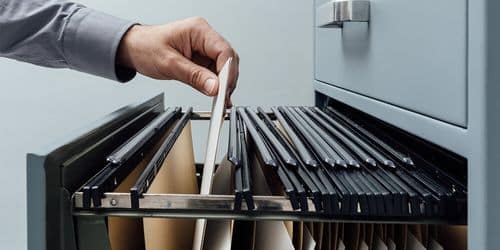Well-structured filing system ideas can help a business to keep its affairs orderly. This way, you won’t have to turn everything upside down in search of vital information. In this article, you will find tips on how to file your documents properly, as well as nice ideas on how to set up electronic filing systems for your small business.
Filing Systems For Business
Filing systems have developed throughout time, from filing paperwork in boxes to sophisticated software programs that electronically store information out of sight. Although there are many options available today, all file systems have one common goal: effective record management. With numerous file systems available, it is critical to analyze the qualities of each before deciding on the best one. The most prevalent filing systems are simple to set up and provide an efficient method of file management.
The 3 Types of Filing Systems
#1. Alphabetical Filing
For less than 5,000 documents, alphabetical filing is the most popular file system. Filing by alphabetic order is a method of organizing files based on the names of individuals, corporations, institutions, agencies, subjects, topics, or geographic locations in dictionary order. This approach works well for client or customer name files. Use a relative index when filing subjects. The index is a list of topic names intended to represent each subject in alphabetical order. To determine what topic name to file the entry under, consult the relative index.
#2. Numerical Filing
Arrange files in consecutive order using numbers directly from the record or a provided number when creating a numeric filing system. To retrieve files, most systems employ an index. A numerical filing system boosts productivity by increasing the speed with which files are filed and located. It also enables more accurate identification and more confidentiality. Unlike alphabetic filing systems, it allows for limitless expansions and can handle more than 5,000 records.
#3. Alpha-numeric Filing
Alpha-numeric filing involves the use of both names and numbers. This type of file system is typically used with subject names and numbers. Arrange files alphabetically or by subject title, then by numerical category. For alpha-numeric files, a relative index is required. The number codes given to each alphabetic division will be listed in the index.
Setting Up Electronic Filing Systems For Your Small Business
Here are some ideas on setting up electronic filing systems for your small business:
#1. Make a plan for document retention.
The first step is just additional preparation. You need to set up guidelines and goals before you begin using electronic filing systems for your small business. You will need to develop a general strategy in a few areas:
- Document creation
- Document sharing
#2. Select the best file management program.
Once you’ve decided on a strategy for streamlining your digital transition, you can look into purchasing software. Knowing your budget range, approximate storage requirements, and user count will help you compare options. You should also ensure that your program contains a few crucial functions:
- Simpleness of use
- Sync
- Simple integration
#3. Create a plan for implementation.
It is now time to put your plan and software into action. All of your preparation should pay off once you reach this point.
- Communicate
- Establish permission levels.
- Create rules
- Complement your systems
#4. Make storage arrangements.
It’s now time to put your storage plans into action. Keep a few things in mind while you upload, save, and distribute your files.
- Maintain your organization.
- Create subfolders
- Naming conventions
#5. Plan for ongoing maintenance.
Maintain the flow of the process after your digital filing system is up and running. If left alone and unmaintained, an electronic environment can quickly become congested like a physical one.
- Scheduled maintenance checks
- Document archiving
What You Should Consider While Setting Up Electronic Filing Systems For Your Small Business
#1. Your financial situation
When selecting document management software, make sure it falls inside your budget. Fortunately, there are various low-cost e-filing options available.
#2. The curve of learning
Aside from system costs, it’s critical to consider your abilities as well as the tech-savvy of the rest of your office in order to schedule yourself (and your team) appropriately.
#3. Total number of users
Some systems charge based on the number of users, while others impose minimum (or maximum) user requirements. Before acquiring software, make sure you know how many people will be using it (or a close estimate).
How To File Your Documents Properly
Have you ever kept someone waiting as you rummaged through your desk for an important document? Or have you ever battled to fulfill a deadline because you misplaced a critical computer file? You have to learn how to file your documents properly to avoid these embarrassing situations
Whether you work with paper papers, electronic files, or a combination of the two, keeping them organized and accessible is critical. You’ll save time hunting for items and have the proper information at your fingertips whenever you need it. Here are some tips on how to file your documents properly:
#1. Do not save superfluous papers.
To file your documents properly, avoid the habit of saving everything that comes your way. Take a few moments to scan the information, and keep a file only if it is important to your professional activities or is required by your company. Too many needless documents contribute to clutter and make it more difficult to find things in the future.
#2. Use a uniform naming convention for your files and folders.
Divide a primary folder, for example, into subfolders for customers, vendors, and coworkers. To identify what or who the folders are about, use shorter names. You may even use color coding to help you recognize different folder groups.
#3. Keep relevant documents, regardless of kind, together.
For example, rather than having one folder for presentations for all projects, another folder for spreadsheets for all projects, and so on, keep reports, letters, presentation notes, spreadsheets, and graphics relating to a specific project in a single folder. You’ll be able to find papers for a specific project much faster this way.
#4. Distinguish between ongoing and completed work.
Some people prefer to retain ongoing or present work on their desk or computer desktop until the job is finished. They then relocate it to the appropriate directory, where files of the same category are stored, once completed. Move files you’re no longer working on to the folders where your completed work is saved on a regular basis (for example, weekly or every two weeks).
#5. Do not overfill folders.
If you have a lot of files in one folder, or a lot of subfolders in a single folder, divide them into smaller groupings (subfolders or sub-subfolders). You may, for example, separate a folder called “Business Plan” into subfolders labeled “BP2021,” “BP2022,” and “BP2023.” Similarly, you may subdivide a folder titled Delta Traders for a client into subfolders named “Delta Traders sales presentations” and “Delta Traders contracts.” Rather than having a long list of files, the aim is to organize them into logical folders or subfolders.
#6. Arrange documents chronologically.
To file your documents properly, make the date of a document stand out by highlighting it, adding it to a paper document, or inserting it in the title of an electronic one. This allows you to order your papers chronologically without having to open each one individually. You’ll be able to find them more readily in the future.
#7. Convert paper documents to digital format.
This is handy if you don’t have a lot of space for paper documents, wish to preserve them without entirely destroying them, need to distribute papers electronically, or want to make your information storage more secure. (However, this is not appropriate for many types of documents, such as legal contracts or documents with original signatures, so exercise your best judgment here.)
Filing System Ideas For The Office
The notion of creating, organizing, or cleaning up an office filing system can make even the most courageous among us hide behind a list of other, more pressing “to-dos.” You no longer have to conceal! These tried-and-true ideas can help you get—and keep—your office filing system in tip-top shape.
#1. Color coding
People have been color coding since office paperwork and office file systems were commonplace decades ago. Color coding ideas never fail, and it’s relatively quick and easy to implement, even if you have a particularly complex filing system. Color coding will motivate you to file your documents properly, find files quickly, and make the filing process more enjoyable.
This organizational strategy is ideal for transforming mounds of paper into neat packets that are as predictable as possible.
#2. Digitize
By digitizing files, you are essentially building a paperless filing system. After converting all paper files to digital format, many people find it far easier to organize a digital filing system than a paper filing system. If you prefer to digitize your files, you must first scan and convert your old files, which can be a time- and labor-intensive procedure.
#3. Decide on an expiration date.
This may appear to be a cheat, but reducing the number of files to sort is one of the best ways to manage an office filing system. Weeding out files by content can be difficult since it’s difficult to establish which files must be retained and which can be discarded, but discarding files by age provides a secure, regulated technique to select what you can chuck.
#4. Separate and conquer
If the files you need to arrange are only relevant to certain departments, assign someone from each of those groups to organize their files while you establish an overall file management framework.
Files should be organized on the walls.
Instead of using a filing cabinet or shelf, hang file holders on your walls.
#5. Sort by Importance
Anyone who has ever spent time searching through files knows the desire to find exactly what you need rather than 100 things you don’t. For example, to make document retrieval more fun for everyone, try structuring your office files in order of priority.
#6. Make it a habit to arrange on a regular basis.
Even the best office file system will not keep you organized on its own. It’s advisable to keep this in mind and plan to do a little amount of work on a weekly basis to maintain the system orderly. Contributing a small amount of effort on a regular basis will feel much less onerous than attempting to clear up a year’s worth of mishandled files all at once.
#7. Distinguish Between Ongoing and Completed Work
This brilliant idea simplifies the entire filing method. Files for completed projects can still be organized, but separating them from files for continuing work will make discovering files a lot faster and more efficient.
What Are 5 Basic Filing Systems?
5 basic filing systems include:
- Subject filing
- Alphabetical filing
- Numerical filing
- Geographical filing
- Chronological filing
How Do You Build A Good Filing System?
- Create uniform categories that can readily accept documents written and saved in a variety of paper and electronic formats.
- Conduct a records inventory
- Create a centralized filing system.
- Cull files every year
How Do I Organize My Small Business Filing Systems?
- Hold a brainstorming session
- Sort through all of your current documents
- Gather team input.
- Choose a Simple Ordering System
- Consistently Label Everything
- Consider Color Coding
- Select a Cabinet You Can Grow Into.
Which Filing System Is Mostly Used In Big Organizations?
The vertical filing system is mostly used in big organizations.
Which Is The Most Suitable System Of Filing To All Offices?
The horizontal system of filing is the most suitable system of filing.
Which is the most widely used filing system?
The most natural and popular way to organize files is using an alphabetical approach. Even the most basic alphanumeric system needs filing standards to be established, including written filing procedures, cross-referencing techniques, and procedures for filing duplicate name changes, among other things.
What is the simplest method of file organization?
The simplest form of file organization in DBMS is sequential file structure. This strategy is effective in terms of speed when dealing with big amounts of data because access to the data is accomplished using this way pretty quickly.
What are the 2 most common filing techniques?
The Loose Leaf approach and the Collective method are the two primary filing techniques. Individually filed documents have holes punched in them before being placed in a standard file. It is quite simple to file and remove documents from a file.
What should a small business file for?
Payroll, business costs, credit card statements, bank statements, annual tax returns, quarterly tax returns, inventory, tapes from the cash register, trip journals, and sales and income statements should all be included in these files.
What filing method is considered the most efficient?
Many people believe that the terminal-digit filing system is the most effective. Following the middle unit and the last unit of numbers in this system, the last digit or group of last digits (terminal digits) serves as the main unit utilized for filing.
In Conclusion,
As you prepare to implement a well-structured filing system, your office life will become less cluttered. There will be a learning curve for migrating files online, but it will become easier to handle and maintain with time. The filing system ideas in this guide will give you an insight on how to set up electronic filing systems, even for your small business.
FAQs On Filing Systems For Business
What is a good filing system?
A good filing system should be simple and not overly complicated. At the same time, the file system’s use cannot be surrendered for the sake of simplicity.
What are the modern methods of filing?
The modern methods of filing are classified into vertical and horizontal filing.
Which app is best for keeping documents?
The best apps for keeping documents include:
- Google Docs
- Documents to Go
- Quick Office Pro
- DropBox
- Kingston Office
{
“@context”: “https://schema.org”,
“@type”: “FAQPage”,
“mainEntity”: [
{
“@type”: “Question”,
“name”: “What is a good filing system?”,
“acceptedAnswer”: {
“@type”: “Answer”,
“text”: “
A good filing system should be simple and not overly complicated. At the same time, the file system’s use cannot be surrendered for the sake of simplicity.
“
}
}
, {
“@type”: “Question”,
“name”: “What are the modern methods of filing? “,
“acceptedAnswer”: {
“@type”: “Answer”,
“text”: “
The modern methods of filing are classified into vertical and horizontal filing.
“
}
}
, {
“@type”: “Question”,
“name”: “Which app is best for keeping documents?”,
“acceptedAnswer”: {
“@type”: “Answer”,
“text”: “
The best apps for keeping documents include:
- Google Docs
- Documents to Go
- Quick Office Pro
- DropBox
- Kingston Office
“
}
}
]
}
Related Articles
- 2 Quick Ways to Update Your Old PDF Files
- INCOME TAX: Overview, e Filing and Calculator
- REAL ESTATE SALES: Step by Step Guide To The Sales Process
- Automating Accounts Payable Process: What You Should Know Before Automation
- PAST DUE: Definition, Rent Notice, Invoices (+ Free tips)






